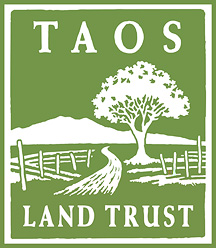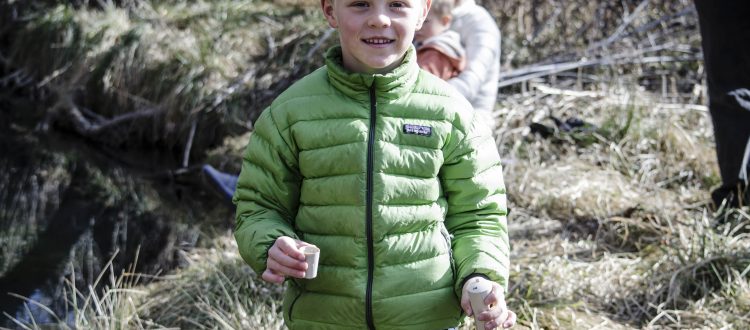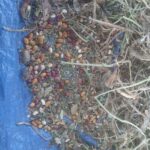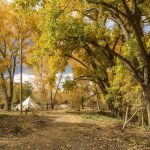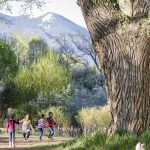Audubon Christmas Bird Count, Keylines and Land Exploration – A Busy Week at Rio Fernando Park
Last week was hopping at the Rio Fernando Park property in Taos. After a few weeks helping our conservation heroes monitor their easements, we hosted the Audubon Christmas Bird Count, set off on our restoration work and had forty-some community members out for our first Land Exploration Event.
Audubon Christmas Bird Count
Back in the late 19th Century, there was an annual event on the East Coast known as the Christmas Side Hunt. Essentially, hunters would chose teams (sides) and head out to shoot every bird they possibly could. The side with the largest pile of dead birds (and often other wildlife) at the end of the day won.
At the same time people (including hunters) began to notice that bird populations were crashing. On Christmas Day 1900, Frank Chapman an ornithologist and co-founder of the Audubon Society had a bright idea. Instead of shooting all those birds how about we count them instead. And thus was born the Audubon Christmas Bird Count. Today thousands of people all over the globe join in on what has become one of the longest-running and largest citizen science projects in the world.
Local volunteers lead by New Mexico Audubon’s Robert Tempelton were out counting birds on our Rio Fernando property Thursday morning. We tracked Robins, Flickers, Nuthatches, Grosbeaks and a number of other species today. And we even saw a Bald eagle! The Audubon Christmas Bird Count runs through January 5th, 2018.

Keyline Plowing
A large part of the Rio Fernando property is old agricultural land that has seen much better days. The soil is compacted and infested with invasive weeds that limit the land’s ability to function to its best capacity. We’ve been working with land restoration experts to develop a plan to restore the Rio Fernando park to a fully functioning healthy ecological system. Dealing with that damaged piece of agricultural land was top of the list.

For three days last week restoration expert Gordon Tooley used a special plow to create keyline contours. In this kind of restoration work, the plowing occurs along a contour line that runs across the land. All the points on the line are at the same elevation as the keypoint. Keylines reduce erosion and allow water to seep into the soil instead of just run off. The deep plowing loosens overly compacted soil allowing roots, earthworms and other underground life to actually move around. At the same time we created the keylines we planted a hearty mix of seeds that will build the soil quality and eventually out compete the weeds and invasive species that have taken over the land. You can learn more about Keyline Contour restoration here. This land renewal work will be going on through 2018 and even beyond. There will be numerous opportunities for community members to help out so be sure to drop by and see!

Land Exploration
Our buddy Silas told us that the Rio Fernando has high conductivity and that’s a problem. Silas is 7 years old. He and a number of other children joined with the 40-some community members who came out to the property on Sunday to participate in our Land Exploration Event.

Water Keeper Eric Patterson helped teach the kids how to test for water quality. It didn’t take Silas long before he could explain that “conductivity” as a measure of water quality means that the water conducts electricity very well. But that is not good. Why? Because it means there is far too much salt and other minerals in the river. These could come from nearby roads, old agricultural fields and even natural sources. Ultimately it means that the river is impaired. Not healthy. Restoring it to its proper function condition is one of our long term goals for the Rio Fernando property.

Water wasn’t the only thing on the menu at the land exploration event. We wanted community input on possible management plans and to generate ideas for the park. And we wanted to probe local people for what they know about invasive species, natives and how to better integrate the park with the needs of our town.
Principal Landscape Architect, Amy Bell, head of FBT Architects/Groundwork Landscape Studio organized the event along with local volunteers such as tree experts Paul Bryan Jones and Ben Wright. Local film maker Peter Parker brought along his drone to get some aerial shots of the park. Some of our local birders were out helping folks learn how to identify the different species that nest or past through the property.

We spread out across the property to look at stands of Siberian elms, for example. These trees were planted as wind breaks back in the day and did a good job. But they got out of control. They are invasive but play various roles, some of them beneficial to soil and wildlife. We looked at old native Box elders and Elderberries along the dry acequia, a massive Lanceleaf cottonwood that is nearing the 100 year mark (at least!) and a group of baby cottonwoods springing up in a dusty field – a good sign they need ground water to get going!
We collected plants from around the property to make art, ate some great enchiladas and topped it off with another sighting of the Bald Eagle!

